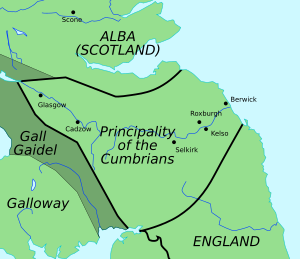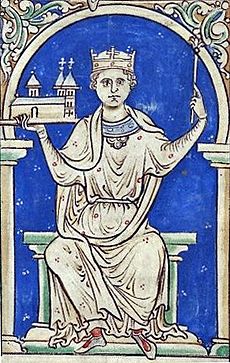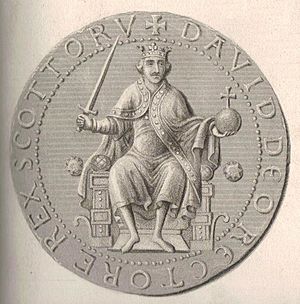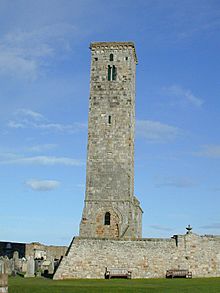David I of Scotland facts for kids
Quick facts for kids David I |
|||||
|---|---|---|---|---|---|
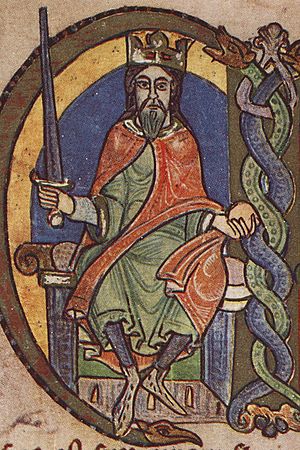 |
|||||
| King of Scotland (more...) | |||||
| Reign | 23 April 1124 – 24 May 1153 | ||||
| Coronation | Scone, April or May 1124 | ||||
| Predecessor | Alexander I | ||||
| Successor | Malcolm IV | ||||
| Prince of the Cumbrians | |||||
| Reign | 1113–1124 | ||||
| Born | c. 1084 | ||||
| Died | 24 May 1153 (aged 68–69) Carlisle |
||||
| Burial | Dunfermline Abbey | ||||
| Spouse | Maud, Countess of Huntingdon | ||||
| Issue | Henry, Earl of Northumberland Hodierna Claricia |
||||
|
|||||
| House | Dunkeld | ||||
| Father | Malcolm III of Scotland | ||||
| Mother | Margaret of Wessex | ||||
David I (born around 1084 – died May 24, 1153) was an important ruler in the 12th century. He was the Prince of the Cumbrians from 1113 to 1124. After that, he became King of Scotland in 1124 and ruled until 1153.
David was the youngest son of King Malcolm III and Queen Margaret. He spent most of his early life in Scotland. However, he was sent away to England for a short time in 1093. Later, he lived at the court of King Henry I of England. There, he learned a lot about Anglo-French culture.
When David's brother, King Alexander I, died in 1124, David decided to become King of Scotland. King Henry I supported him. David had to fight his nephew, Máel Coluim mac Alaxandair, who also wanted the throne. It took David about ten years to defeat him. This struggle included defeating Óengus, the leader of Moray.
After Henry I died, David supported his niece, Empress Matilda, who was Henry's daughter, in her claim to the English throne. This led to conflicts with King Stephen of England. David was able to gain more power in northern England, even though he lost the Battle of the Standard in 1138. David I is considered a saint by the Catholic Church. His feast day is celebrated on May 24.
Many historians use the term "Davidian Revolution" to describe the big changes that happened in Scotland during his time as king. These changes included setting up new towns called burghs and local markets. He also helped reform the church, founded monasteries, and changed the Scottish government to be more like the Norman system. He also brought in feudalism with knights from France and Anglo-Norman areas.
Contents
Early Life of David I
David was born in Scotland around 1084. He was the youngest son of King Malcolm III and his second wife, Queen Margaret. He was also the grandson of King Duncan I.
In 1093, David's father, King Malcolm, and his brother Edward were killed during a fight in Northumberland. David and his brothers, Alexander and Edgar, were likely there when their mother died soon after. Later stories say that their uncle, Donald III, became king and forced David and his brothers to leave Scotland.
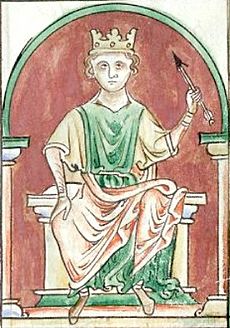
King William Rufus of England did not like Donald becoming king. He sent David's older half-brother, Duncan, to Scotland with an army. Duncan was killed within a year. So, in 1097, William sent another half-brother, Edgar, who was more successful and became king.
During these power struggles (1093–1097), David was in England. He was about nine years old in 1093. We don't know much about David's life between 1093 and 1103. However, he seems to have been in Scotland for some of the 1090s. When King William Rufus died, his brother Henry Beauclerc took power. Henry married David's sister, Matilda. This marriage made David the brother-in-law of the English king. From then on, David was an important person at the English court. Even though he grew up with a Gaelic background, David became very Normanised during his time in England.
David's Early Rule (1113–1124)
Prince of the Cumbrians
David's brother, King Edgar, gave David a lot of land south of the river Forth in Scotland. When Edgar died in 1107, his younger brother Alexander became king. David likely took control of his new lands soon after Edgar's death. However, he didn't officially control them until he founded Selkirk Abbey in late 1113. Historians believe that King Henry I's support helped David claim his inheritance in southern Scotland.
King Henry's backing probably made King Alexander accept David's claims without a fight. Some native Scots were not happy about David's actions. An old Gaelic poem complained about "Máel Coluim's son" (David) dividing them from Alexander. The lands David gained included areas like Roxburghshire, Selkirkshire, and Lanarkshire. David also got the title princeps Cumbrensis, meaning "Prince of the Cumbrians." This was a large part of Scotland south of the Forth River.
David also set up large lordships in these lands. For example, he gave Annandale to Robert de Brus.
Earl of Huntingdon
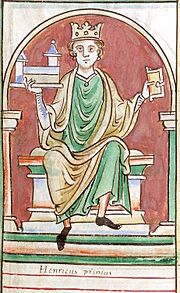
In late 1113, King Henry arranged for David to marry Matilda of Huntingdon. She was the daughter and heir of Waltheof, Earl of Northumberland. This marriage gave David the "Honour of Huntingdon," which included lands in Northampton, Huntingdon, and Bedford. Within a few years, Matilda gave birth to a son, whom David named Henry after his powerful patron.
These new territories greatly increased David's wealth and power. He became one of the most important nobles in England. Matilda's father, Waltheof, had been the Earl of Northumberland. This was a large area in northern England. After King Henry's death, David tried to get this earldom for his son, Henry.
David spent a lot of his time outside Scotland, in England and Normandy. Even after his sister died in 1118, David remained in King Henry's favor. This was important when his brother Alexander died in 1124, leaving Scotland without a king.
David's Kingship in Scotland
David had spent his childhood in Scotland. However, some historians say he didn't have strong ties to Scottish culture at first. But they also argue that he became more connected to Gaelic culture later in his reign. David's claim to the Scottish throne was not straightforward. Scottish law did not follow the Norman rule where the oldest son always inherited the throne. David was the youngest of eight sons. Other kings had sons, like William fitz Duncan and Máel Coluim mac Alaxandair. However, neither of them had the support of King Henry I, unlike David. So, when Alexander died in 1124, the Scottish nobles had to choose between accepting David as king or facing war with both David and Henry I.
Becoming King and Early Struggles
Alexander's son, Máel Coluim, chose to fight. He tried to take the kingdom from David. They fought two fierce battles. David, who had more power and wealth, defeated Máel Coluim and his followers. Máel Coluim escaped to parts of Scotland not yet controlled by David, where he found help.
In April or May 1124, David was crowned King of Scotland at Scone. The coronation ceremony involved many old Scottish traditions. Ailred of Rievaulx, a friend of David, wrote that David did not like these traditional ceremonies. He was only persuaded by the bishops to take part.
In the 1120s, David had little power outside his Cumbrian lands and southern Scotland. He was "king of Scots in little more than name." He spent most of his time between 1127 and 1130 in Scotland. However, he also visited Henry I's court in England. In 1130, David's wife, Matilda of Huntingdon, died. While David was still in England, a rebellion broke out in Scotland. His nephew Máel Coluim led it, with the support of Óengus of Moray. Óengus was a powerful leader who also had a claim to the throne.
The rebels marched into Angus. They were met by David's army, led by his constable, Edward. A battle took place near Brechin. According to old records, 1,000 of Edward's soldiers and 4,000 of Óengus's army died, including Óengus himself. Edward then marched north into Moray, taking control of that area. However, Máel Coluim escaped, and the civil war continued for four more years. This was a "struggle for survival" for David.
David asked King Henry for military help. Henry sent a large fleet and an army of Norman knights. The fleet was used in the Irish Sea and along the Argyll coast, where Máel Coluim was hiding. In 1134, Máel Coluim was captured and put in prison.
Bringing Peace to the West and North
During this time, David gave land to his supporters. For example, Walter fitz Alan received Strathgryfe. This suggests that David gained these territories after the 1130–34 campaign.
We don't know how long it took to bring peace to Moray. David appointed his nephew, William fitz Duncan, to rule Moray. William may have married Óengus's daughter to strengthen his power there. David also founded new towns like Elgin and Forres to help control Moray. He also founded Urquhart Priory, a monastery, and gave it a share of the tribute from Argyll.
A marriage was also arranged between the son of Matad, Mormaer of Atholl, and the daughter of Haakon Paulsson, the Earl of Orkney. This marriage helped secure the northern border of Scotland. It also offered the chance for a Scottish noble's son to gain control of Orkney and Caithness. By the time Henry I died in 1135, David controlled more of Scotland than ever before.
Controlling the North
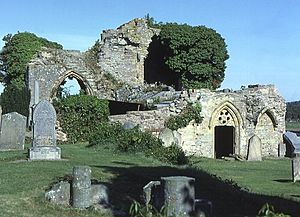
While fighting King Stephen and trying to control northern England, David also worked to control the far north of Scotland. In 1139, his young cousin, Harald Maddadsson, was given the title of "Earl" and half the lands of Orkney, along with Scottish Caithness. Throughout the 1140s, Caithness and Sutherland came under Scottish control. Before 1146, David appointed a Scot named Aindréas as the first Bishop of Caithness.
By 1150, it seemed that Caithness and Orkney would become permanently Scottish. However, David's plans faced problems. In 1151, King Eystein II of Norway sailed to Orkney with a large fleet. He surprised Harald and forced him to promise loyalty to Norway. David quickly responded by supporting Harald's rival, Erlend Haraldsson, giving him half of Caithness. But King Eystein also gave the same Erlend a similar grant, canceling David's move. David's weakness in Orkney was that the Norwegian kings would not let him reduce their power.
David's Relationship with England
David's actions regarding England are often seen in two ways. First, his early career was greatly shaped by King Henry I of England. David was Henry's brother-in-law and a close supporter. His opposition to Stephen can be seen as an effort to support Henry I's daughter, Empress Matilda, who was David's niece. David fought his wars in her name and later knighted her son, Henry.
Second, David's policy towards England can also be seen as an attempt to create a "Scoto-Northumbrian" kingdom. This means he wanted to take the northernmost parts of England for Scotland. David's family ties to the House of Wessex (an old English royal family) and his son Henry's ties to English earls of Northumberland might have encouraged this plan. This project ended only when Henry II later forced David's grandson and successor, Máel Coluim IV, to give back most of David's gains. Both interpretations likely hold some truth.
Stephen Becomes King and the First Treaty
Henry I had planned for his daughter, Empress Matilda, to inherit the English throne. However, Stephen, Henry's nephew, took the throne instead in December 1135. David had been the first lay person to promise to support Matilda's claim in 1127. So, when Stephen was crowned, David decided to go to war.
Before December 1135 ended, David marched into northern England. By January, he had taken several castles, including Carlisle and Newcastle. By February, David was in Durham, where King Stephen's army met him. Instead of fighting, they agreed to a treaty. David kept Carlisle, and his son Henry was given back the Earldom of Huntingdon. Stephen got back the other castles. David did not have to pay homage to Stephen, but Henry did for his English lands. Stephen also promised that if the Earldom of Northumberland was ever brought back, Henry would be considered first. The issue of Matilda was not mentioned. However, this treaty quickly broke down because David was insulted by how his son Henry was treated at Stephen's court.
War Continues: Battle of Clitheroe
In early 1137, David prepared to invade England again. He gathered an army on the border of Northumberland. The English gathered their own army. Again, a big battle was avoided, and they agreed to a truce until December. When December came, David demanded that Stephen give him all of the old Earldom of Northumberland. Stephen refused, leading to David's third invasion in January 1138.
The Scottish army that invaded England in 1138 shocked English writers. They described it as a "savage army" that "destroyed, pillaged and burned" towns and churches. Stories of terrible acts were recorded by chroniclers.
By February, King Stephen marched north. The two armies avoided each other, and Stephen soon went south. In the summer, David split his army. He sent William fitz Duncan to Lancashire, where he attacked Furness and Craven. On June 10, William fitz Duncan fought an English force. The battle, called the battle of Clitheroe, was a big victory for the Scots.
Battle of the Standard and Second Treaty
By late July 1138, the two Scottish armies met again near Durham. Another English army had gathered, led by William, Earl of Aumale. David's victory at Clitheroe probably made him confident enough to risk another battle. David's army, reportedly 26,000 strong, met the English on August 22 at Cowdon Moor.
The battle, known as the Battle of the Standard, was a defeat for the Scots. David and his remaining nobles went back to Carlisle. Even though it was a defeat, it wasn't a complete disaster. David still had most of his army and could fight again. For example, the siege of Wark, which had been going on since January, continued until the castle was captured in November. David continued to control Cumberland and much of Northumberland.
On September 26, Cardinal Alberic arrived at Carlisle. He was there to settle a church dispute. Alberic helped make peace, and David agreed to a six-week truce. On April 9, David and Stephen's wife, Matilda of Boulogne (who was also David's niece), met at Durham and agreed to a new settlement. David's son Henry was given the Earldom of Northumberland and was restored to the Earldom of Huntingdon. David himself was allowed to keep Carlisle and Cumberland. King Stephen kept control of the important castles of Bamburgh and Newcastle. This agreement largely achieved David's goals for the war.
Matilda Arrives and New Conflicts
The peace with Stephen did not last long. When Empress Matilda arrived in England, David had a chance to restart the conflict. In May or June, David traveled south to join Matilda. He was present for her planned coronation, which never happened. David stayed with her until September.
This civil war, later called "the Anarchy", allowed David to strengthen his position in northern England. He took control of the castles at Newcastle and Bamburgh again. He gained control over all of England north-west of the river Ribble and the Pennines. He also held the north-east down to the river Tyne. David rebuilt the fortress of Carlisle, which became his favorite home. David also gained control of the silver mines at Alston. This allowed him to start making Scotland's first silver coins.
Church Disputes
David's biggest disappointment during this time was not being able to control the bishopric of Durham and the archbishopric of York. David tried to appoint his chancellor, William Comyn, as Bishop of Durham. Comyn was the unofficial bishop from 1141 to 1143. However, the church leaders did not like him. David could not get the support of the Pope's representative, Henry of Blois, so he gave up.
David also tried to influence who would become Archbishop of York. William FitzHerbert, Stephen's nephew, was removed by the Pope. David tried to support the new archbishop, Henry Murdac. However, Stephen's supporters prevented Henry from taking his post. In 1149, Henry asked David for help. David saw this as a chance to bring the archdiocese under his control and marched on York. But Stephen's supporters warned the king, who sent a new army to the city. David decided not to risk a battle and withdrew. Some historians believe David wanted to bring all of the old kingdom of Northumbria under his rule. This event was a turning point, as he lost the chance to greatly change the map of Britain.
Scottish Church Changes
It was once thought that David I created Scotland's church system. Today, historians have a more balanced view. Ailred of Rievaulx wrote that when David became king, there were only "three or four bishops in the whole Scottish kingdom" north of the Forth. When he died, there were nine. David moved the bishopric of Mortlach to his new town of Aberdeen. He also helped create the diocese of Caithness.
The bishopric of Glasgow was restored by David. He appointed his chaplain, John, as bishop. David also helped make semi-monastic "bishoprics" like Brechin and Dunkeld into full bishoprics. This helped them become part of a national church system.
David did not create the system of local churches (parishes). Scotland already had old parish churches. David's changes made the Scottish system more like those in France and England, but he did not create it from scratch.
Church Conflicts
One of David's first problems as king was a dispute with the English church. The English church wanted Scottish bishops to be under the control of the archbishops of York or Canterbury. This issue had stopped Robert of Scone from becoming Bishop of St Andrews since 1124. The bishopric of St Andrews had acted like an archbishopric for a long time.
The problem was that the Pope had not officially recognized St Andrews as an archbishopric. This allowed English archbishops to claim power over the Scottish church. The Archbishop of York, Thurstan, was very aggressive about this. His easiest target was the bishopric of Glasgow, which was south of the Forth River. In 1125, Pope Honorius II ordered John, Bishop of Glasgow, to submit to the Archbishop of York. David ordered Bishop John to go to Rome to get a special cloth called a pallium. This would make the bishopric of St Andrews an archbishopric with power over Glasgow.
Thurstan and the Archbishop of Canterbury also went to Rome and likely opposed David's request. However, David got King Henry's support. The Archbishop of York agreed to delay the issue for a year and to consecrate Robert of Scone without demanding his submission. York's claim over bishops north of the Forth was mostly dropped during David's reign. However, York kept its claims over Glasgow.
In 1151, David again asked for a pallium for the Archbishop of St Andrews. A cardinal met David in Carlisle. The cardinal was on his way to Ireland to create four new Irish archbishoprics. When the cardinal returned, David made his request. David wanted the new archdiocese to include all the bishoprics in his Scottish territory, as well as Orkney and the Isles. Unfortunately for David, the cardinal did not seem to bring this up with the Pope. The next year, the Pope created the archbishopric of Trondheim in Norway. This new archbishopric included the bishoprics of the Isles and Orkney, which was a setback for David.
Succession and Death
Perhaps the biggest setback for David happened on July 12, 1152. His only son and heir, Henry, Earl of Northumberland, died. Henry had likely been sick for a long time. David himself had less than a year to live and probably knew his time was short. David quickly arranged for his grandson, Malcolm IV, to be his successor. His younger grandson, William, was made Earl of Northumberland. Donnchad I, Mormaer of Fife, a leading noble, was appointed as a regent. He took the 11-year-old Malcolm around Scotland to meet his future subjects and gain their loyalty. David's health got much worse in the spring of 1153. He died on May 24, 1153, in Carlisle Castle. In an old record, he is called "David, son of Malcolm, King of Scotland and England." This title shows how important the new English parts of his kingdom had become.
Davidian Revolution
Historians agree that major changes happened during David I's reign. These changes are often called the "Davidian Revolution." This "revolution" laid the groundwork for how Scotland would be governed in the later Middle Ages. The changes David started grew into many of the main systems of the kingdom.
Historians now see David's "revolution" as part of a larger "European revolution" happening at the same time. From the late 900s onwards, the culture and systems of old European heartlands spread to other areas. Scotland was one of these "outlying" areas.
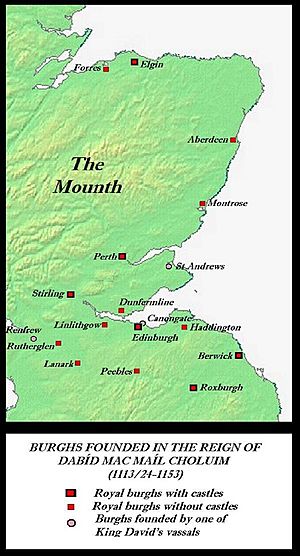
Government and Feudalism
David brought in many foreign knights and changed how land was owned. Land ownership moved from old customs to a more formal system called feudalism. This completely changed how Scotland was governed. Royal officials were placed in new castles that were built across the country. These officials helped with law enforcement and tax collection, making Scotland more like other European kingdoms.
During David's reign, Scotland saw new ways of governing and the arrival of foreign knights, mostly from France. The start of feudalism in Scotland is usually linked to David. This included building castles, using professional cavalry (horse soldiers), and formal agreements of loyalty. David set up large feudal lordships in his Cumbrian lands for the French military leaders who supported him. Many smaller feudal lordships were also created.
Steps were taken to make the government in Scotland more like Anglo-Norman England. New sheriffdoms allowed the King to manage royal lands effectively. Royal sheriffs were set up in key areas like Roxburgh, Scone, and Stirling. The office of Justiciar, a high legal official, was also created during David's reign.
Economy
The money from his English earldom and the silver mines at Alston allowed David to produce Scotland's first coins. These coins changed how trade worked and improved his image as a powerful ruler.
David was a great town builder. As Prince of the Cumbrians, he founded Scotland's first two burghs (towns) at Roxburgh and Berwick. Burghs were settlements with clear boundaries and guaranteed trading rights. They were places where the king could collect and sell goods. David founded about 15 burghs in total.
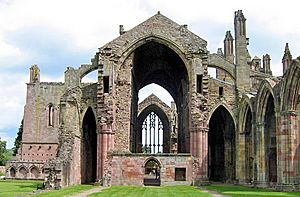
Burghs were very important during David's reign. At first, they were mainly for foreign merchants. However, they greatly changed Scotland's economy and culture in the long run. These planned towns were mostly English in culture and language. An English writer noted that "the towns and burghs of the Scottish realm are known to be inhabited by English." This English influence eventually weakened the position of the Middle Irish language and led to the development of the Scottish Lowlands.
Monastic Support
David was one of Scotland's greatest supporters of monasteries. In 1113, he founded Selkirk Abbey for the Tironensian monks. David founded more than a dozen new monasteries during his reign, supporting various new monastic orders.
These monasteries showed David's strong religious faith. They also helped change Scottish society. Monasteries became centers of foreign influence. They also provided educated men who could help the crown with its growing administrative needs. These new monasteries, especially the Cistercian ones, brought in new farming methods. For example, Cistercian monks helped turn southern Scotland into a major source of sheep wool in northern Europe.
Genealogical table
| David's relationship with the kings of Scotland and England |
|---|
Fictional Portrayals
- David the Prince (1980) by Nigel Tranter. This book tells the story of Queen Margaret's sons, Alexander I and David I.
See also
 In Spanish: David I de Escocia para niños
In Spanish: David I de Escocia para niños


